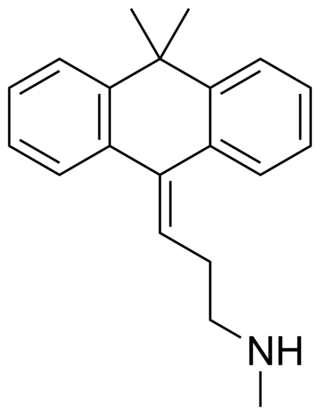ATC code J01Antibacterials for systemic use is a therapeutic subgroup of the Anatomical Therapeutic Chemical Classification System, a system of alphanumeric codes developed by the World Health Organization (WHO) for the classification of drugs and other medical products. Subgroup J01 is part of the anatomical group J Antiinfectives for systemic use.

The first pass effect is a phenomenon of drug metabolism whereby the concentration of a drug, specifically when administered orally, is greatly reduced before it reaches the systemic circulation. It is the fraction of drug lost during the process of absorption which is generally related to the liver and gut wall. Notable drugs that experience a significant first-pass effect are buprenorphine, chlorpromazine, cimetidine, diazepam, ethanol, imipramine, insulin, lidocaine, midazolam, morphine, pethidine, propranolol, and tetrahydrocannabinol (THC).

In humans, Erysipelothrix rhusiopathiae infections most commonly present in a mild cutaneous form known as erysipeloid or fish poisoning. E. rhusiopathiae can cause an indolent cellulitis, more commonly in individuals who handle fish and raw meat. Erysipelothrix rhusiopathiae also causes Swine Erysipelas. It is common in domestic pigs and can be transmitted to humans who work with swine. It gains entry typically by abrasions in the hand. Bacteremia and endocarditis are uncommon but serious sequelae. Due to the rarity of reported human cases, E. rhusiopathiae infections are frequently misidentified at presentation.

Flucloxacillin, also known as floxacillin, is an antibiotic used to treat skin infections, external ear infections, infections of leg ulcers, diabetic foot infections, and infection of bone. It may be used together with other medications to treat pneumonia, and endocarditis. It may also be used prior to surgery to prevent Staphylococcus infections. It is not effective against methicillin-resistant Staphylococcus aureus (MRSA). It is taken by mouth or given by injection into a vein or muscle.

Colestipol is a bile acid sequestrant used to lower blood cholesterol, specifically low-density lipoprotein (LDL). It is also used to reduce stool volume and frequency, and in the treatment of chronic diarrhea.

Phenoxymethylpenicillin, also known as penicillin V (PcV) and penicillin VK, is an antibiotic useful for the treatment of a number of bacterial infections. Specifically it is used for the treatment of strep throat, otitis media, and cellulitis. It is also used to prevent rheumatic fever and to prevent infections following removal of the spleen. It is given by mouth.

Petrichloral is a sedative and hypnotic chloral hydrate prodrug. It is a Schedule IV drug in the USA.

Solute carrier family 22 member 8, or organic anion transporter 3 (OAT3), is a protein that in humans is encoded by the SLC22A8 gene.

Benzylpenicillin, also known as penicillin G (PenG) or BENPEN, and in US military slang "Peanut Butter Shot" is an antibiotic used to treat a number of bacterial infections. This includes pneumonia, strep throat, syphilis, necrotizing enterocolitis, diphtheria, gas gangrene, leptospirosis, cellulitis, and tetanus. It is not a first-line agent for pneumococcal meningitis. Due to Benzylpenicillin's limited bioavailability for oral medications, it is generally taken as an injection in the form of a sodium, potassium, benzathine, or procaine salt. Benzylpenicillin is given by injection into a vein or muscle. Two long-acting forms benzathine benzylpenicillin and procaine benzylpenicillin are available for use by injection into a muscle.

Benzathine benzylpenicillin, also known as benzathine penicillin G, is an antibiotic medication useful for the treatment of a number of bacterial infections. Specifically it is used to treat strep throat, diphtheria, syphilis, and yaws. It is also used to prevent rheumatic fever. It is given by injection into a muscle.
Procaine benzylpenicillin also known as penicillin G procaine, is an antibiotic useful for the treatment of a number of bacterial infections. Specifically it is used for syphilis, anthrax, mouth infections, pneumonia, diphtheria, cellulitis, and animal bites. It is given by injection into a muscle.

Propicillin is a penicillin. Properties are similar to benzylpenicillin particularly used in streptococcal infections, not resistant to penicillinase. It is acid resistant and can be used orally as the potassium salt.

The aminopenicillins are a group of antibiotics in the penicillin family that are structural analogs of ampicillin. Like other penicillins and beta-lactam antibiotics, they contain a beta-lactam ring that is crucial to its antibacterial activity.
ATCvet code QG51Antiinfectives and antiseptics for intrauterine use is a therapeutic subgroup of the Anatomical Therapeutic Chemical Classification System for veterinary medicinal products, a system of alphanumeric codes developed by the World Health Organization (WHO) for the classification of drugs and other medical products for veterinary use. Subgroup QG51 is part of the anatomical group QG Genito-urinary system and sex hormones.
ATCvet code QJ51Antibacterials for intramammary use is a therapeutic subgroup of the Anatomical Therapeutic Chemical Classification System for veterinary medicinal products, a system of alphanumeric codes developed by the World Health Organization (WHO) for the classification of drugs and other medical products for veterinary use. Subgroup QJ51 is part of the anatomical group QJ Antiinfectives for systemic use.
Octamoxin, also known as 2-octylhydrazine, is an irreversible and nonselective monoamine oxidase inhibitor (MAOI) of the hydrazine class that was used as an antidepressant in the 1960s but is now no longer marketed.

Litracen (N-7,049) is a tricyclic antidepressant which was never marketed.

Benzilylcholine mustard is a modified version of acetylcholine, so named because after cyclization in solution it forms an iminium derivative that is structurally similar to benzilylcholine. It is well known for being an irreversible antagonist of the muscarinic acetylcholine receptor. It has been used in pharmacological experiments investigating the relationship between receptor occupancy and response. It was also one of the tools in characterization of the muscarinic acetylcholine receptor.
Benzathine benzylpenicillin/procaine benzylpenicillin, sold under the brand name Bicillin C-R, is an antibiotic medication. It contains the antibiotics benzathine benzylpenicillin and procaine benzylpenicillin.













